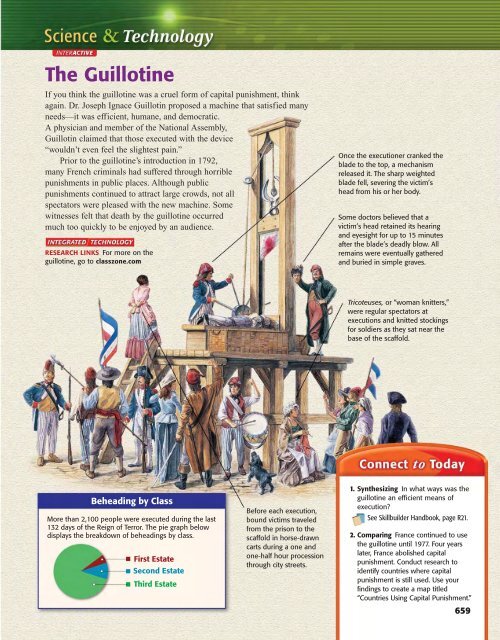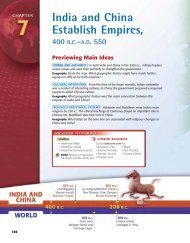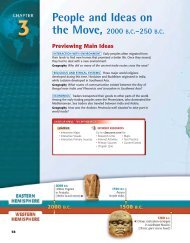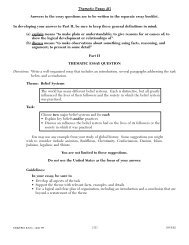The French Revolution and Napoleon, 1789-1815 - First
The French Revolution and Napoleon, 1789-1815 - First
The French Revolution and Napoleon, 1789-1815 - First
You also want an ePaper? Increase the reach of your titles
YUMPU automatically turns print PDFs into web optimized ePapers that Google loves.
<strong>The</strong> Guillotine<br />
If you think the guillotine was a cruel form of capital punishment, think<br />
again. Dr. Joseph Ignace Guillotin proposed a machine that satisfied many<br />
needs––it was efficient, humane, <strong>and</strong> democratic.<br />
A physician <strong>and</strong> member of the National Assembly,<br />
Guillotin claimed that those executed with the device<br />
“wouldn’t even feel the slightest pain.”<br />
Prior to the guillotine’s introduction in 1792,<br />
many <strong>French</strong> criminals had suffered through horrible<br />
punishments in public places. Although public<br />
punishments continued to attract large crowds, not all<br />
spectators were pleased with the new machine. Some<br />
witnesses felt that death by the guillotine occurred<br />
much too quickly to be enjoyed by an audience.<br />
RESEARCH LINKS For more on the<br />
guillotine, go to classzone.com<br />
Beheading by Class<br />
More than 2,100 people were executed during the last<br />
132 days of the Reign of Terror. <strong>The</strong> pie graph below<br />
displays the breakdown of beheadings by class.<br />
<strong>First</strong> Estate<br />
Second Estate<br />
Third Estate<br />
Before each execution,<br />
bound victims traveled<br />
from the prison to the<br />
scaffold in horse-drawn<br />
carts during a one <strong>and</strong><br />
one-half hour procession<br />
through city streets.<br />
Once the executioner cranked the<br />
blade to the top, a mechanism<br />
released it. <strong>The</strong> sharp weighted<br />
blade fell, severing the victim’s<br />
head from his or her body.<br />
Some doctors believed that a<br />
victim’s head retained its hearing<br />
<strong>and</strong> eyesight for up to 15 minutes<br />
after the blade’s deadly blow. All<br />
remains were eventually gathered<br />
<strong>and</strong> buried in simple graves.<br />
Tricoteuses, or “woman knitters,”<br />
were regular spectators at<br />
executions <strong>and</strong> knitted stockings<br />
for soldiers as they sat near the<br />
base of the scaffold.<br />
1. Synthesizing In what ways was the<br />
guillotine an efficient means of<br />
execution?<br />
See Skillbuilder H<strong>and</strong>book, page R21.<br />
2. Comparing France continued to use<br />
the guillotine until 1977. Four years<br />
later, France abolished capital<br />
punishment. Conduct research to<br />
identify countries where capital<br />
punishment is still used. Use your<br />
findings to create a map titled<br />
“Countries Using Capital Punishment.”<br />
659
















